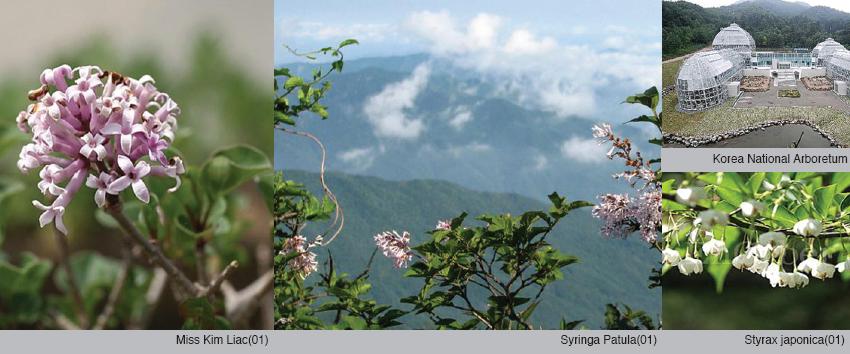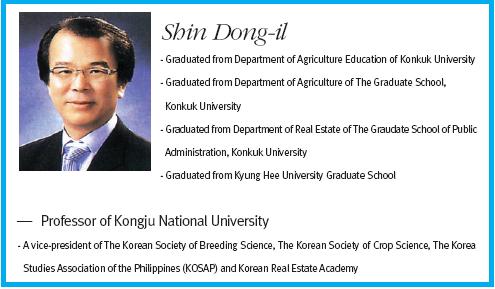
Have you ever heard the Korean native plant Syringa patula? In 1947, Elwin M. Meader, a plant collector from the U.S., found a seed of Syringa patula on Baekundae, Seoul’s highest peak, located in mountain Bukhan National Park. And the seed became an improved breed ‘Miss Kim Lilac’ (Syringa patula ‘Miss Kim’) and it has been reimported to Korea. Eventually, the improved breed has become popular in the worldwide flower market. Then, have you ever heard of common watched plant of Korea Styrax japonica? Extracts of Styrax japonica’s bark are known to have excellent efficacy for developing a medication for Alzheimer’s.
Likewise, today, plant resources’ importance is pervading the whole industry, not only wonder drug development but also the food industry, agriculture, and the environment. Now, to understand the growing importance, plant resources, The Sookmyung Times with professor Shin Dong-il (Shin) of the department of Plant Resources in Kongju National University, went to the plant resources’ new world.
Part 1, Briefing Plant Resources
Professor Shin said plant resources are organic living things’production activities that people use systemically and
commercially for a fixed purpose.
▶Objects
The first object is understanding about new techniques and management practices based on cultivation, heredity, ecology and environment for efficient production and use of food, medicine, and cash crops for humans. The second is training of human power which has knowledge about plants and they will engage in agriculture by ompletion of various subjects related with improving the environment. The third is upbringing of experts who can contribute high and eco-friendly production technology, rearing new breeds and quality improvement.
▶Employments and Future View
The students who study plant resources can be employed in national institutes like the Rural Development ministration and the National Institute of Agricultural Science and Technology. They also go to work at individual enterprises such as botanical gardens, NongHyup (Farmer’s Cooperate), agri-chemical companies, fertilizer companies and soil environment management venture businesses. Recently, the importance of stable food security is increasing because of a sudden rise of global grain prices, so overseas agriculture acumen development is attracting public attention.
Part 2, Curious Questions & Clear Answers
Q. What’s the difference between Horticulture and plant resources?
A. Horticulture is a study which learns gardening of vegetables, fruit trees and flowing plants and landscape
gardening in priority. The other side, plant resources is a study which systemizes ability for rational agriculture production and management. That’s final goal is development of agriculture.
Q.Is agriculture development a positive influence in today’s society which withers agriculture?
A.Agriculture is essential for people’s lives as the first industry. Agriculture was developed from accumulated experiences in the early days, but has gradually developed from concentrated study. With science technology development, we can have better farm produce than before. And in the future, following the growth of
biotechnology, new breeds and crops which satisfy consumers’ various tastes will appear.
Q. There is a seed bank which keeps endangered plant’s seeds at Kew Gardens in England. What kind of works are there to protect the seeds in Korea?
A. In 1987, the Rural Development Administration also established a seed bank. Through the seed bank, we can
preserve useful genes of each kind of seed and prevent extermination. Study of Plant Resources can make a new breed through various confusions by lotting-out seeds of the seed bank.
Part 3, Professor’s Recommended Books
▶Korea Wildness Edibility Plant Resources 1,2, Han Yongbong, Korea University Press, 2002
- This book’s biggest characteristics are well-arranged information about edible wild plant components or lesser-known physiological activities, and presentation of picture data which make it easily accessible to the public.
▶An Agronomical Enumeration of Korean Plant Resources, Ahn Haksu, Ilchokak, 1982
- This illustrated plant book gathers expert information.
▶ Genetic Resource Botany, Kim Sungmin, Kongju National University Press, 2008
- This university’s teaching materials for classes of the department of Plant Resources introduced plants’ diversity and genetic resources.
The author of Donguibogam which is the famous medical book of Korea, Heo Jun, a court physician at Chosun Dynasty in Korea said, “The disease which can’t be cured with foods also can’t be cured with medicines.” The department of Plant Resources’ professor Shin said that food production containing material which can prevent all
diseases and aging in people’s food is the final object of Plant Resources. Plant resources is not a study about withered agriculture any longer. It is a new eco-friendly global technology and an important resource based on essential agriculture for future food and industry. For example, College of Industrial Sciences Yesan Campus
in Kongju National University is steadily growing into an ‘Agriculture and Biotech Globalization University.’ The department of Plant Resources will review the old and learn the new, so the study is going toward the world.



